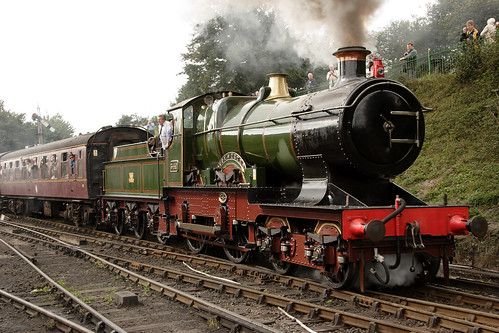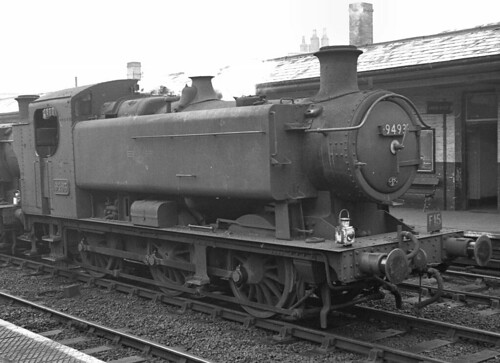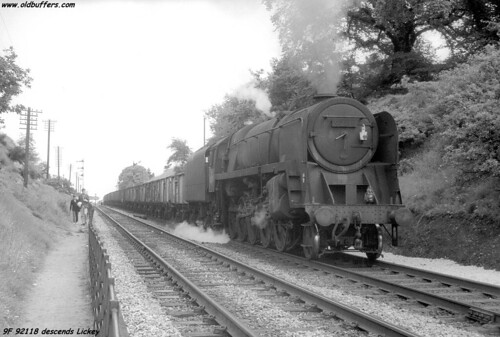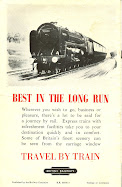 |
| Copyright Ben Brooksbank |
Welcome
Monday, December 19, 2011
Bevy of five 0-6-0T bankers about to drop down the Lickey Incline back to Bromsgrove
Sunday, December 18, 2011
More photographs from Ben Brooksbank
The LNER Garratt on the Lickey Incline below Blackwell
 |
| Copyright Ben Brooksbank |
 |
| Copyright Ben Brooksbank |
7017 'G.J. Churchward' was built in August 1948. First shed allocation - Old Oak Common. August 1950 - shed allocation Cardiff Canton. Last shed allocation - Old Oak Common. Withdrawn February 1963. Scrapped at A. King & Son, Norwich.
7007 Great Western was built as Ogmore Castle, July 1946. it was the last passenger express engine built at Swindon. First shed allocation Wolverhampton, Stafford Road. Renamed January 1948 as 'Great Western', the same name as the first locomotive built at Swindon. August 1950 and March 1959 shed allocations Worcester. Double chimney and 4 row superheater fitted March 1961. Last shed allocation Worcester. Withdrawn February 1963. Scrapped at Cashmore's, Great Bridge.
GW loco info per The Great Western Archive
To the Chocolate Factory!
 |
| Copyright Ben Brooksbank |
Worcester - Birmingham stopping train ascending Lickey Bank
 |
| Copyright Ben Brooksbank |
Two WR '9400' 0-6-0 Panniers on the Lickey
 |
| Copyright Ben Brooksbank |
Riddles 9F hard at work
 |
| Copyright Ben Brooksbank |
Four '9400' class 0-6-0 Pannier tanks banking
 |
| Copyright Ben Brooksbank |
Bromsgrove Shed
 |
| Copyright Ben Brooksbank |
Friday, July 15, 2011
Toy and train auctions
Vectis have another sale coming up on the 23rd July with many lots including:
Railwayana
Minic Railway
Hornby Dublo 3-rail Locos & Sets
Hornby Dublo 3-rail Rolling Stock & Accessories
Hornby Dublo 2-rail Locos and Sets
Hornby Dublo 2-rail Rolling Stock and Accessories
Wrenn Railways
Triang Railways
Triang TT
Triang Minic Motorway
Trix Trains
HO Brass
Brass British Outline
Hornby O Gauge Locomotives
Hornby O Gauge Rolling Stock
Bassett-Lowke & Further O Gauge Locomotives
More information here http://www.vectis.co.uk/
Tuesday, July 12, 2011
The Lickey Incline
| Blackwell at the top of the Lickey Incline, looking down towards Bromsgrove, Malverns in the distance |
Monday, July 04, 2011
Tuesday, June 14, 2011
Tuesday, June 07, 2011
Watching trains on film
Saturday, June 04, 2011
More illustrations by the artist A N Wolstenholme
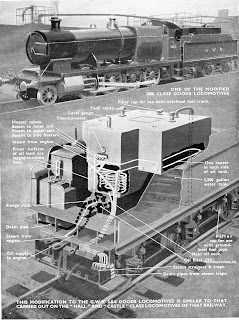 |
| Tender arranged for oil firing
Drawing by A N Wolstenholme
|

 |
| Cab and Firebox arranged for oil firing on GWR 2-8-0 Drawing by A N Wolstenholme |
Monday, May 30, 2011
The railway artist A N Wolstenholme
 |
| An improved Thompson Pacific
|
 |
| An improved Stanier Pacific |
Little is known of Wolstenholme's life and he is now in the process of being re-discovered and his work deserves greater recognition. But see my later postings on Wolstenholme
For more pictures of A N Wolstenholme's work see the following sites:
The Science Museum here
and Mike Ashworth's Flickr site here
Phil Beard's blog has some illustrations and comments on ANW's work for Ian Allan here
Dave Rowland's excellent
British Railways - Passenger Train map, c1954 - illustration by A N Wolstenholme
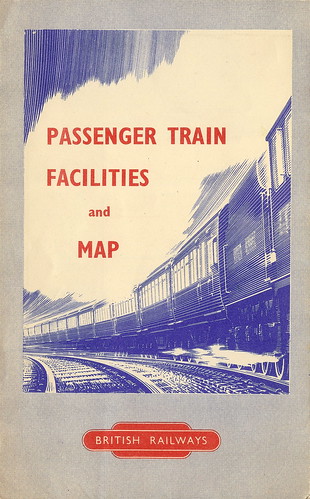
British Railways - Passenger Train map, c1954 - illustration by A N Wolstenholme, originally uploaded by mikeyashworth.
A N Wolstenholme was frequently commissioned to produce scraperboard illustrations for BR and other transport publications in the 1950s. Here, the front cover of the BR system map sees a steam hauled express racing along.
British Railways

British Railways - new diesel train service Birmingham - South Wales, leaflet illutrated by A N Wolstenholme - 1957, originally uploaded by mikeyashworth.
British Railways - new diesel train service Birmingham - South Wales, leaflet illustrated by A N Wolstenholme - 1957
British Electric Trains

British Electric Trains by H W A Linecar, second edition 1948 - cover by A N Wolstenholme, originally uploaded by mikeyashworth.
British Electric Trains by H W A Linecar, second edition 1948 - cover by A N Wolstenholme
Sunday, May 15, 2011
Model railway history - G & R Wrenn Ltd for Sale - 1989
G & R Wrenn Ltd made a loss of £34,000 in 1987 on sales of £201,000 and in 1988 increased sales to £252,000 and made a small profit of £1,133. Illustrated here are extracts from the accounts for the year end 31 December 1988 that were sent to those enquiring about the sale together with a copy of the supporting letter from G R Wrenn the managing director. A copy of the 7th edition catalogue was also sent out.
In November 2001, three collectors of Wrenn model railways bought the G. & R. Wrenn Company from Dapol, acquiring the Company name, the Registered Trade Marks, the original tools and presses (with the exception of the wagon tools that had been absorbed into the Dapol production lines) and all of the remaining parts and spares. They have subsequently gone into limited production of short runs of Wrenn models. For more information on the history of Wrenn and the current activities of the company see here
Should anyone wish to have a copy of the sales letter and the full set of accounts (13 pages) without the watermark please send a cheque for £10 payable to BHA Consultants Ltd at the following address
 |
| Wrenn Profit and Loss |
 |
| Wrenn Balance Sheet |
 |
| Wrenn Catalogue - Title page |
 |
| Wrenn Catalogue - back page |
Saturday, April 09, 2011
Lickey Incline Book - Bromsgrove to Gloucester
The main route from the bottom of the Lickey Incline to Gloucester is covered in this excellent book. The historical background is provided and the railway, its trains and infrastructure, are shown as it was in the past and with more recent views plus maps of the junctions and stations on the way. The branch from Ashchurch to Great Malvern and Tewkesbury is also covered, with all photographs having detailed informative captions.
(Middleton Press 'Midland Main Lines' Series)
94xx class 8409+9493 banking through Bromsgrove station. 2 March 1963

94xx class 8409+9493 banking through Bromsgrove station. 2 March 1963, originally uploaded by ricsrailpics.
Hawkesworth pannier tanks - when labour was relatively cheap and the BR time and motion people had one assumes not looked at the Lickey Incline operations! Picture and copyright by Richard Postill - excellent photographer with a very good collection of heritage/archive railway pictures from the 1960s
Lickey bankers returning through Bromsgrove. 25 January 1964
92118 on the Lickey
Riddles designed British Railways Standard Class 9F 2-10-0 92118 starts to descend the Lickey Incline in the 1960s.
Image copyright 2011, The Steve Jones Collection.
(Originally featured on the now defunct 'OldBuffers' website.)
44981 on the Lickey
Stanier 'Black 5' 44981 starts to descend the Lickey Incline in the 1960s.
Image copyright 2011, The Steve Jones Collection.
(Originally featured on the now defunct 'OldBuffers' website.)
Wednesday, March 23, 2011
Large Engines on the Lickey Incline: 1956-1964
 |
| Riddles 9F |
 |
| GWR 7200 class 2-8-2 No 7202 at Severn Tunnel Junction 26 April 1964. Copyright - Richard Postill |
 |
| 42XX GWR 5235 Severn Tunnel Junction. 26 April 1964. Copyright Richard Postill |
 |
| Riddles 2-10-0 on shed |
 |
| Riddles 9F at Wolverhampton |
Source: 'The Railway History of Bromsgrove and the Lickey Incline' Part 2
'A miscellany of local railway events, operating practices, banking engines, services and a locomotive traffic survey, for the period 1949-1983. Compiled by Robert Danes on behalf of the Bromsgrove Steam Enthusiasts Club.
This is an excellent anthology of information on the Lickey Incline. Part 1 does not seem to have been published. Attempts to trace Mr Danes have come to nought and the Club no longer seems to function.
See more of Richard Postill's splendid photographs of steam on British Railways here
Sunday, March 13, 2011
Working the Lickey Incline - 1949 - 1956
This period is dominated by the two visits of the ex LNER Beyer-Garratt Class VI 2-8-8-2T No. 69999 and, of course, the final years of the ex- Midland Railway 0-10-0 No. 58100, known by all as 'Big Bertha'.
The need for a large banking engine specifically to work on the Lickey Incline had been recognised as long ago as 1845 by Joseph McConnell, the locomotive engineer who was the superintendent of the Birmingham-Gloucester Railway from 1842. He built an 0-6-0 saddle tank weighing about 30 tons, No. 38, named 'Great Britain', which was capable of hauling 135 tons up the Incline at 8-10 mph. This engine was rebuilt at least twice before final scrapping in 1901 after 56 years service. The concept of a specialised banking engine had been established.
The Midland Railway continued this tradition when they began to consider a special banker in 1911. During the next few years various designs were considered, including a 2-10-0 tank locomotive, an articulated 2-6-6-2 tank engine and an 0-6-6-0 tank loco with a rigid frame. In the event the design adopted was an 0-10-0, the only decapod tender engine in service at the time. She was the most powerful and largest engine built for the Midland Railway with four enormous cylinders (16t-in x 28-in stroke) and a tender cab which was essential as she spent half her life in reverse and protection for the crew was imperative. The specially superheated boiler originally fitted was numbered 4886; a second similar boiler No. 5395 was fitted in December 1922 and these two boilers were then fitted alternately through the engine's life.
The newly-built engine was recorded in the erecting shop at Derby Works at the end of November 1919 ready for painting. The first steaming took place on 1 January 1920 at Derby and the engine, numbered 2290, was soon despatched to Bromsgrove, arriving on 20 January 1920.
 |
| The Midland Railway's Lickey Banker |
It was to remain at Bromsgrove for the next 36 years other than occasional visits to Derby Works for overhaul, and a very brief spell on trial, hauling coal trains between Toton and Brent in 1924. This was not a success and no further similar engines were built. The powerful headlight for buffering up in the dark was fitted in 1921, the current being provided by a steam turbo generator fitted in front of the cab below the running plate on the left-hand side. The tender could hold 2050 gallons of water and 4 tons of coal - each ascent consumed about 7 cwt.
The principal features of the new engine were the ten coupled wheels, four simple-expansion cylinders, and a steam distribution arrangement by which two ordinary piston valves regulated the steam supply to four cylinders. With one exception - that of the well-known "Decapod" tank locomotive formerly on the Great Eastern Railway - the new Midland engine was the first locomotive working in Britain to run upon five coupled axles, and was therefore the first tender engine built for the home railways of the 0-10-0 type.
 |
| Great Eastern Railway - James Holden's Decapod |
As a British freight engine it was also unique in employing four cylinders working with simple expansion; and the valve arrangement was a novelty in the UK since it represented the simplest means known for distributing steam to four cylinders, needing no rocking levers, extra valves, etc, and therefore adding not one single moving part to the valve motion over and above what was required for an ordinary two-cylinder machine. The system adopted by Sir Henry Fowler merits particular attention. Walschaerts' gear, of exceedingly light and elegant design, and arranged with a maximum cut-off of 75% drove an outside-admission piston valve situated in the normal position above the outside cylinder.
The front piston valve head served the front port of the outside cylinder and the back port of the outside cylinder and vice versa, the ports of the latter cylinder being crossed and the cranks of course set at a relative angle of 180 degrees. This arrangement achieved two ends: firstly it secured the utmost freedom from the complications which detract from the recognised benefits of multi-cylindering, and secondly, it solved the problem of suitably locating valves for the interior cylinders when these had to be placed high up with little room to spare between them and the smoke box floor. The only disadvantage apparent lay in the disparity of the clearance between the direct and cross-ported cylinders, but with an engine intended for such highly specialised service as this locomotive under notice, this objection was not really a problem. In foreign examples of this univalvular dual distribution, the valve was generally situated above and between the two cylinders, and thus the clearances were more or less equalised, but this was out of the question in this Midland engine by reason of the lack of space, and moreover usually demanded the slight additional complication of a rocker or other means of transferring the movement from the valve gear to the valve spindle.
The drive from all cylinders was taken by the third or central pair of wheels. This allowed adequately long connecting rods for all sets of motion and the placing of four cranks upon the middle axle was also advantageous in other respects. In order that the connecting rods could clear the second axle without unduly raising and inclining the cylinders, that axle was slightly cranked in two places, thus giving clearance to the connecting rods when the cranks were near their lowest points. The cylinders were composed of a two-piece casting, bolted together in the central vertical plane, and were inclined at a slope of 1 in 7 to the horizontal. Their covers at the back and front were of the same diameter, which enabled the cylinders for both sides of the engine to be cast from one pattern. Cylindrical bushes were fitted to the outside big-ends and coupling rod pins, with the exception of those of the leading wheels, where the bearings were adjustable. Reversing is effected by a steam-operated servo-motor placed near the reversing arm shaft, pipes from the footplate controlling the steam and cataract cylinder valves. Great attention had been paid to the lubrication, both cylinders and axle boxes being supplied by mechanical pumps of the Midland Company's own type.
Suspension for all wheels was by flat laminated springs with compensating beams between the first and second, fourth and fifth axles. Brakes were applied to all wheels, the first three pairs being actuated by a steam cylinder behind the crank shaft, and the two rear pairs by an independent cylinder located under the drag box. An engine hand brake was also provided, acting upon all wheels, as it was deemed inadvisable to rely solely upon a tender hand brake, in consequence of the relative lightness of the tender by comparison with the great weight of the engine.
 |
| Big Bertha waiting for a train |
The boiler was furnished with a Midland type super-heater of 27 elements. The firebox was 10 ft long and had a grate area of 311 sq ft. It was tapered in two directions, the crown sloping downwards towards the back, and the two sides inwards in the same direction, the back plate being in fact similar to that used on the Midland compound express engine. Though actually designed for a pressure of 200 Ib per sq in, the normal working pressure was 180 lb per sq in, at which pressure the four safety valves were set to discharge. The feed was by two hot water injectors, and special provision was made for warming the water in the tender by utilising steam which otherwise would have been dissipated at the safety valves.
The tender was of moderate size arid weight, and fitted with a neat but spacious shelter. As the service required was intermittent, there was no necessity for large fuel and water capacity, opportunities for replenishment being frequent. It was first intended to construct the engine as a ten-coupled tank, but preference was eventually given for a tender, this permitting a large boiler without unduly loading the wheels, the maximum axle weight being the very moderate one of 15~ tons on the middle pair of wheels.
'Big Bertha' as she beame known was from the outset well liked and a popular engine and was to pound up and down the Incline for successive crews over many years, amassing an unbelievable 838,856 miles by the time of her withdrawal in May 1956. In 1947 and late 1948 she had been renumbered 22290 and then 58100.
During the last six or seven years of her life covered by this record she shared all the banking duties with the Class 3F 0-6-0 'Jinty' tank engines which had been introduced in 1924. The regular engines of this class at Bromsgrove during this time were:
47257/47276/47301/47303/47305/47308/47425/47502/47565/ 47635. They were supplemented by the 21C-allocated Class 3F 0-6-0 locomotives 43186/43462/43667.
In March 1950 she was recorded at Derby Works in ex-works lined black, was back at the Works in January 1954 and again in November 1954 when she was noted on both occasions in the erecting shop. On 16 April 1955 she banked the special railtour 'The Lickey Limited' hauled by Castle Class 7017 'G J CHURCHWARD' (an unusual visitor) with the ex-LNER observation car at the rear, but by June she was back at Derby for a routine boiler examination.
While she was away ex-LNER Garratt 69999 arrived in August (more about this later) at the same time as British Railways Standard Class 9F 2-10-0 No. 92008 for trials as an assistant banker. All these developments gave rise to a rumour that the withdrawal of 58100 was imminent and the local newspaper printed an obituary. Bromsgrove crews were reported as petitioning Derby for a reprieve and one driver proposed to organise a farewell dinner to 'BIG BERTHA', to which Bromsgrove engine crews past and present, senior railway officials, railway enthusiasts and civic dignitaries would be invited. However, this was not necessary as no decision had been made to withdraw 58100 and she was back at work by late August.
Unfortunately, the reprieve was only temporary because withdrawal took place only a few months later in the 3-week period ending 19th May 1956. She was stored at Derby Works from May 1956 to March 1957 being cleaned up for her final appearance at the Works Open Day in August 1956. There was some suggestion of preservation but cutting up took place on 6th/7th April 1957 in the erecting shop with only the special multiple cylinder block being retained as a relic of this unique locomotive.
Whilst 'BERTHA' had been performing as well as ever in her last years, it was a different story for the Garratt 69999. Built in 1925 by Beyer-Peacock (see Pathe News clip below) for banking duties on the Worsborough Incline (between Wath and Manchester on the Woodhead route) she became redundant in 1949 when the line was electrified. It was decided to send her to Bromsgrove to be tried on the Lickey Incline, so she was officially transferred to 2lC arriving on 7 March 1949. When she arrived she was the wrong way round according to local drivers; wrong way because it was preferable for the cab-end to lead on the ascent making buffering up easier.
 |
| The LNER Beyer Garratt at work |
She was accordingly taken to Worcester to turn on their turntable but was too long and was returned to Bromsgrove; the problem was solved by running her up to Kings Norton and turning her on the Lifford triangle. Initially her use as a banker was limited because a local railwayman stated that "it only worked between 11 am and 3 pm because the inspector in charge is on a day turn and must not be delayed in reaching home by 5 o-clock".! She was noted on 23 July 1949 banking trains hauled by Class 5's 44665 and 44802, still bearing MEXBORO on her buffer beam.
69999 was to remain at Bromsgrove for only just over a year because by June 1950 she was noted at Derby Works and by November 1950 was back on the Eastern Region. After a period in store at Mexborough she was noted banking at Worsborough in May 1951. The Bromsgrove locomen had a poor opinion of the engine - it would not steam properly, consumed 4/5 cwt of coal more than 'BIG BERTHA' for every ascent (which made it hard work for the fireman), and had very poor braking capabilities. Some typical comments were:
"it wouldn't steam properly"
"it's a useless great thing, always short of steam"
These views, however, were not new; as long ago as 1933 a certain Mr Beastall of the LNER during a discussion about synchronisation of the Garratt exhausts went on record as saying
"these questions are asked in view of the fact that we are experiencing some little trouble with the steaming of the Garratt engine under my supervision at Mexborough "
There was one occasion in March 1950, recounted in some detail in a railway periodical of the time, when ex-LMS Garratt 47972 arrived at Bromsgrove with 42 loaded wagons and was banked up Lickey by 69999. The train stalled half-way and had to be rescued by 58100 'BIG BERTHA'
Having been returned to Mexborough as unsuitable for banking on the Lickey, the authorities had to decide what to do with her. The events of the next 3 years are catalogued below:
April 1951
Consideration given to the fitting of a mechanical stoker, but the idea was rejected
August 1952
Gorton Works received authority to fit oil burning equipment in order for the engine to work on the Lickey Incline. It would also receive an electric headlamp together with the necessary generators and conducting and a larger steam-pipe from the cab to the brake cylinder on the leading wheel unit. So both the steaming and braking problems were tackled
August/ September 1952
At Gorton Works receiving attention and modifications
November 1952
Acquired electric headlight
December 1952
Ex-works at Gorton (7/12/52), conversion to oil-burning complete
21 December 1952
Ex-works 69999 worked a test train from Dewsnap sidings (near Manchester) to Dunford Bridge, on the Woodhead route. The load was equal to 41 heavy wagons and the schedule (including a 10 minute waterstop) was 61 minutes from Dinting to Dunford. The actual time was 175 minutes including a 33 minute stop at Woodford, the main problem being shortage of steam
July 1953
Gorton Works under repair
August/ September 1953
Another test run to Woodhead took place, but no details are available
11 October 1953
A 43-wagon train was hauled from Dewsnap Yard to Crowden to test the steaming characteristics
November 1953
At Gorton in a "woebegone" condition
18 March 1954
The Garratt left Dewsnap Sidings at 12.45 pm with a test train of some 40 wagons, in a dense cloud of smoke
October 1954
Back at Gorton Works
By this time, over three years had been spent trying to get things right and 69999 had been in and out of works many times. Whether by now everyone was satisfied or had just done their best and run out of patience and resolve, is not known. What is clear is that the authorities decided to send 69999 back to Bromsgrove to give her another try at banking. She was despatched from Gorton on 29 June 1955 and reached Kings Norton before failing with a hot-box. This caused her to return to Burton Shed (where she stayed at least from 30 June to 5 July presumably en route back to Derby, the nearest works. She finally arrived at Bromsgrove on 7 August 1955, being used' on the first trip on 9 August. By 23 August there was a notable trio at Bromsgrove comprising 69999, 58100 and 92008 (still on trial), the 9F being the only engine of the three in steam.
After a brief period of banking, which was no more successful than her previous efforts as a coal burner in 1949-50, she was retired to Bromsgrove Shed where she was noted on 8 September "be-grimed and dead". By 18th September 1955 she was at Burton Shed, being officially transferred to 178 Burton during September, followed quickly by her official transfer back to 39A Gorton, recorded as the 4-week period ending 22nd October 1955. She was condemned in November and on New Year's Day 1956 was observed at Doncaster Works, awaiting scrapping. So all the efforts to improve this locomotive had been unsuccessful and in hindsight it might have been better if she had been consigned to the scrapheap in 1949.
The withdrawal of these two giants within 6 months of each other signalled the end of an era on the Lickey; steam banking was to continue for another 8 years but with much more modern locomotives and even ex-GWR motive power.
Source: 'The Railway History of Bromsgrove and the Lickey Incline' Part 2
'A miscellany of local railway events, operating practices, banking engines, services and a locomotive traffic survey, for the period 1949-1983. Compiled by Robert Danes on behalf of the Bromsgrove Steam Enthusiasts Club.
This is an excellent anthology of information on the Lickey Incline. Part 1 does not seem to have been published. Attempts to trace Mr Danes have come to nought and the Club no longer seems to function.
Film of the LNER Garratt here
THE MONSTER - FILMED AT GORTON, MANCHESTER
Saturday, March 12, 2011
Railways in Film
 Apart from the many amateur and professional clips of railway subjects on YouTube such as the British Transport Commission Film 'This is York'' and 'Paddington Station 1939' from the film 'The Last Journey'. The BBC has an 'on line ' archive as part of its 'Nation on Film' site here.
Apart from the many amateur and professional clips of railway subjects on YouTube such as the British Transport Commission Film 'This is York'' and 'Paddington Station 1939' from the film 'The Last Journey'. The BBC has an 'on line ' archive as part of its 'Nation on Film' site here. Many of the films featured in Railways in the Cinema can be rented from LoveFilm.com
